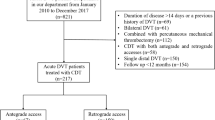Abstract
This study compares the development of reflux, recanalization, and clinical outcomes of patients with femoral-popliteal and iliofemoral deep venous thrombosis (DVT). Emphasis is placed on the relationship between early lysis of clot through thrombolysis and the development of reflux and post-thrombotic syndrome (PTS) for iliofemoral patients. A retrospective chart review was conducted of 27 femoral-popliteal DVT limbs and 11 iliofemoral DVT limbs with average follow-up of 2.3 and 2.1 years, respectively. Rates of recanalization, development of reflux, and post-thrombotic syndrome were recorded through review of duplex scans and physical examinations. All femoral-popliteal patients received anticoagulant therapy. Nine of 11 iliofemoral patients (82%) received thrombolytic therapy in addition to anticoagulants. Statistical analysis included Kaplan-Meier estimation to take into account dropout in follow-up times, and chi-squared analysis to compare final outcomes. A significantly greater proportion of iliofemoral patients (73%) than femoral patients (31%) remained asymptomatic at the end of their follow-up (p < 0.025). Because of thrombolytic therapy, 82% of iliofemoral limbs showed partial or complete lysis 4 weeks after diagnosis of clot. As expected, only 22% of femoral-popliteal limbs developed some recanalization 4 weeks after diagnosis (p < 0.005). Interestingly, no significant difference in reflux development was observed between the two groups. After an average of 2.1 years, 60% of femoral-popliteal limbs developed reflux in the deep veins vs. 64% for iliofemoral limbs. The iliofemoral DVT patients showed improved clinical outcomes in the short term compared to that of femoral-popliteal patients in this pilot study. The improved clinical outcomes could be attributed to the early lysis of clot via thrombolytic therapy for the iliofemoral group. Although the extent of reflux development was similar in both groups, iliofemoral patients still showed fewer clinical symptoms after follow-up. This may suggest that the presence of both residual obstruction and reflux, rather than either one alone, significantly increases the chances for development of PTS. Since thrombolytics eliminates at least one of these factors, residual obstruction, it may aid in decreasing development of PTS in the short term. The data in this retrospective study warrant further long-term prospective analysis of thrombolysis and its relationship with PTS.





Similar content being viewed by others
References
AJ Comerota (2002) ArticleTitleQuality-of-life improvement using thrombolytic therapy for iliofemoral deep venous thrombosis Rev Cardiovasc Med 3 IssueIDSuppl 2 S61–67
UK Franzeck I Schalch KA Jager et al. (1996) ArticleTitleProspective l2-year follow-up study of clinical and hemodynamic sequelae after deep vein thrombosis in low-risk patients (Zurich Study) Circulation 93 74–79
EM Masuda DM Kessler RL Kistner B Eklof DT Sato (1998) ArticleTitleThe natural history of calf vein thrombosis: lysis of thrombi and development of reflux J Vasc Surg 28 67–73
C Kearon (2003) ArticleTitleNatural history of Venous thromboembolism Circulation 107 I-22–I30
EM Masuda RL Kistner B Eklof (1994) ArticleTitleProspective study of duplex scanning for venous reflux: comparison of Valsalva and pneumatic cuff techniques in the reverse Trendelenburg and standing positions J Vasc Surg 20 711–720
InstitutionalAuthorNameKaplan-Meier Estimator. (1982) Encyclopedia of Statistical Sciences, Vol 4 Wiley-Interscience New York 346–351
MW Mewissen (2001) ArticleTitleCatheter-directed thrombolysis for lower extremity deep venous thrombosis Tech Vasc Interv Radiol 4 111–114
M Elsharawy E Elzayat (2002) ArticleTitleEarly results of thrombolysis vs anticoagulation in iliofemoral venous thrombosis. A randomised clinical trial Eur J Vasc Endovasc Surg 24 209–214 Occurrence Handle10.1053/ejvs.2002.1665
BF Johnson RA Manzo MS Bergelin DE Strandness (1995) ArticleTitleRelationship between changes in the deep venous system and the development of the post-thrombotic syndrome after an acute episode of lower limb deep vein thrombosis: a one-to-six-year follow-up J Vasc Surg 21 307–312
LA Killewich GR Bedford KW Beach DE Strandness (1989) ArticleTitleSpontaneous lysis of deep venous thrombi: rate and outcome J Vasc Surg 9 89–97 Occurrence Handle10.1067/mva.1989.vs0090089
Markel A, Manzo R, Bergelin R, Strandness E. Valvular reflux after deep vein thrombosis: incidence and time of occurrence. J Vasc Surg 1989;377-384
MH Meissner RA Manzo RO Bergelin A Markel DE Strandness (1993) ArticleTitleDeep venous insufficiency: the relationship between lysis and subsequent reflux J Vasc Surg 18 596–608 Occurrence Handle10.1067/mva.1993.48276
JP Saarinen K Domonyi R Zeitlin J Salenius (2002) ArticleTitlePostthrombotic syndrome after isolated calf deep venous thrombosis: the role of popliteal reflux J Vasc Surg 36 959–964
Acknowledgments
We thank Fedor Lurie, MD, PhD, for his guidance and support with this vascular study. We also thank the Straub Foundation and Straub Hospital staff for their support.
Author information
Authors and Affiliations
Corresponding author
About this article
Cite this article
Singh, H., Masuda, E.M. Comparing Short-Term Outcomes of Femoral-Popliteal and Iliofemoral Deep Venous Thrombosis: Early Lysis and Development of Reflux. Ann Vasc Surg 19, 74–79 (2005). https://doi.org/10.1007/s10016-004-0133-3
Published:
Issue Date:
DOI: https://doi.org/10.1007/s10016-004-0133-3




